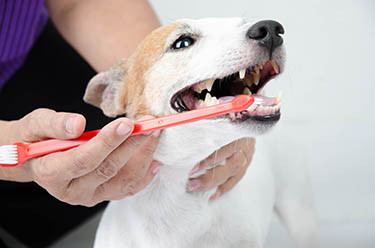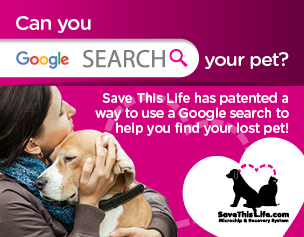How can you prevent your dog from developing periodontal disease?

Although canine periodontal disease is a serious problem, the good news for dogs and their owners is that the condition, if detected early enough, is extremely preventable.
Take your dog in for regular vet checkups
From day one, your dog should visit the vet for a health check at least once a year. Your pet’s checkup can be scheduled to coincide with his annual booster vaccinations, saving him the stress of an extra trip to the clinic.
A dental and oral health check will form part of this annual review. The dental check will allow your vet to highlight any potential problems that may be brewing and treat them accordingly, thus helping to prevent canine periodontal disease.
Between checkups, it is up to you to look after your dog’s oral hygiene at home.
Perform daily toothbrushing
Ideally, you should brush your dog’s teeth every day to get rid of plaque and thus prevent the formation of tartar (dental calculus).
Daily brushing is very important, as it only takes a few days exposure to the dog’s saliva for the plaque biofilm to be transformed into hard tartar. Once your pet’s teeth have a coating of tartar, a veterinary dental cleaning is required to remove it. If tartar is allowed to form unchecked, your pet will develop gingivitis, and ultimately, periodontal disease.
The right tools for the job
Before you attempt to brush your dog’s teeth, you must equip yourself with the right tools for the job.
Pet toothbrushes look much like human ones, but with a smaller head and a longer handle. Pet toothbrushes are often double-ended, allowing you to choose a small or large brush head, depending on what your dog finds most acceptable. Use a soft-bristle brush of a size suitable for the dog’s oral cavity. Your veterinarian will recommend the appropriate size brush for your dog.
Never use human toothpaste to clean your dog’s teeth!
Unlike their human owners, dogs don’t spit and rinse when their teeth are brushed! Human toothpaste contains substances that can lead to liver damage in your canine companion.
Human toothpaste also contains xylitol, a sugar substitute. Dogs that swallow xylitol and absorb it are at risk of an initial insulin surge followed by a catastrophic drop in blood sugar. Xylitol can also cause severe liver disease in dogs. In addition, some brands of human toothpaste contain baking soda and other abrasive substances that are irritants to a dog’s digestive tract.
For these reasons, you must use only pet-specific toothpaste or gel to clean your dog’s teeth. These products come in pet-friendly flavors such as beef, chicken, or peanut butter. In addition, they contain special enzymes, which kill bacteria to discourage the formation of plaque.
You can obtain pet-specific toothbrushes, pastes, and gels from your vet or from a reputable pet supply store.
How to brush your dog’s teeth

This is a process that should be introduced gradually, and you must be patient. Use plenty of praise throughout your dog’s toothbrushing lessons, and reward him with petting or play so that the sessions are always fun.
Never use force to try to restrain your dog. If your dog becomes aggressive or distressed, stop immediately and consult your vet for advice.
- Start by gently stroking the outside of your dog’s face with your finger. Carefully lift up his lip to expose the outside surfaces of the teeth and gums.
- Repeat the process as above, but this time put a small blob of toothpaste on your finger and allow your pet to taste it.
- Dampen your pet’s toothbrush, add a small amount of toothpaste, and very gently clean the gums and teeth, especially the back upper molars and canines where plaque tends to accumulate.
- Concentrate on brushing the outer cheek-facing tooth surfaces; the dog’s tongue will naturally spread the enzyme-rich toothpaste to the inner surfaces and other hard-to-reach areas.
Provide your pet with quality toys and chews
In addition to hard rubber chews, fibrous, rope-style toys can provide effective self-cleaning devices for your dog’s teeth. As he plays, his teeth penetrate the material, wiping away plaque and massaging his gums, but this can also lacerate the gingiva.
Although it is not advisable to feed natural bone that may splinter and harbor bacteria, rawhide dental chews can be helpful in rubbing away plaque from the teeth while your dog enjoys munching on his treat.
Ensure your pet follows a healthy diet
A diet that comprises predominantly soft food can leave a dog vulnerable to greater accumulations of plaque than an animal fed mainly hard kibble and biscuits.
If your dog is prone to oral health problems, your vet may recommend a diet that is formulated to include ingredients that will slow plaque mineralization and decrease oral bacteria. The Veterinary Oral Health Council provides helpful information about vet-approved plaque and calculus-control products for dogs.
Prevention of gingivitis and periodontal disease is possible
- Annual veterinary dental checks are essential for your pet.
- Daily home tooth brushing/cleaning is the best method of preventing gingivitis and periodontal disease. Human toothpaste is not safe for use in dogs.
- Hard rubber chews, fibrous, rope-style toys can provide effective self-cleaning devices for your dog’s teeth.
- Ask your vet about a diet that will slow plaque mineralization and decrease oral bacteria.
About Dr. James Anthony
Dr. James Anthony has been involved in veterinary medicine for
over 30 years. He is a boarded Veterinary Dentist since 1989 (Diplomate of the AVDC).
Dr. Anthony has had an extensive academic career as well, having
taught veterinary dentistry at the University of Guelph, the University of Montreal and the University of Prince Edward Island. He was also a Tenured Professor at the University of Saskatchewan as the Head of
Veterinary Oral Surgery and Dentistry.
Dr. Anthony has authored over 40 articles and book chapters, and throughout his career has lectured globally at veterinary meetings.


Working Here
Our team members are encouraged to be the best they can be... at Covetrus we believe we impact one another.
Learn MoreNews & Events
FDA Cautions Pet Owners Not to Feed Texas Tripe Inc. Raw Pet Food Due to Salmonella, Listeria Monocytogenes
The U.S. Food and Drug Administration is cautioning pet owners not to feed their pets any of the Texas Tripe brand raw frozen pet food listed below because several samples of Texas Tripe raw pet food have tested positive for Salmonella and/or L. mono.
Careers
Are you looking for a place to let your talents shine? At Covetrus, we help our practitioner customers better serve their patients and take pride in providing the best customer experience possible. Search our open positions to see our available opportunities.
Newsletter
Stay current with what’s going on with Covetrus, subscribe to receive our newsletter and email communications. Subscribers will receive the latest information in practice management, sales and marketing, animal health, and more.



-3-(1).png?sfvrsn=2d806d73_0)

Leave a comment